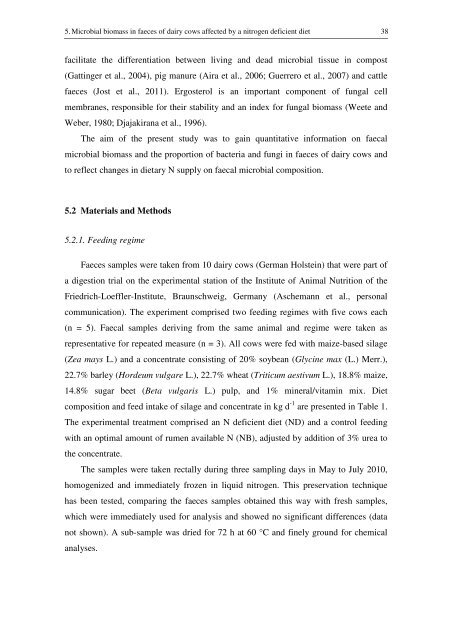Fütterungsbedingte mikrobielle Zusammensetzung von Rinderkot ...
Fütterungsbedingte mikrobielle Zusammensetzung von Rinderkot ...
Fütterungsbedingte mikrobielle Zusammensetzung von Rinderkot ...
Create successful ePaper yourself
Turn your PDF publications into a flip-book with our unique Google optimized e-Paper software.
5. Microbial biomass in faeces of dairy cows affected by a nitrogen deficient diet 38<br />
facilitate the differentiation between living and dead microbial tissue in compost<br />
(Gattinger et al., 2004), pig manure (Aira et al., 2006; Guerrero et al., 2007) and cattle<br />
faeces (Jost et al., 2011). Ergosterol is an important component of fungal cell<br />
membranes, responsible for their stability and an index for fungal biomass (Weete and<br />
Weber, 1980; Djajakirana et al., 1996).<br />
The aim of the present study was to gain quantitative information on faecal<br />
microbial biomass and the proportion of bacteria and fungi in faeces of dairy cows and<br />
to reflect changes in dietary N supply on faecal microbial composition.<br />
5.2 Materials and Methods<br />
5.2.1. Feeding regime<br />
Faeces samples were taken from 10 dairy cows (German Holstein) that were part of<br />
a digestion trial on the experimental station of the Institute of Animal Nutrition of the<br />
Friedrich-Loeffler-Institute, Braunschweig, Germany (Aschemann et al., personal<br />
communication). The experiment comprised two feeding regimes with five cows each<br />
(n = 5). Faecal samples deriving from the same animal and regime were taken as<br />
representative for repeated measure (n = 3). All cows were fed with maize-based silage<br />
(Zea mays L.) and a concentrate consisting of 20% soybean (Glycine max (L.) Merr.),<br />
22.7% barley (Hordeum vulgare L.), 22.7% wheat (Triticum aestivum L.), 18.8% maize,<br />
14.8% sugar beet (Beta vulgaris L.) pulp, and 1% mineral/vitamin mix. Diet<br />
composition and feed intake of silage and concentrate in kg d -1 are presented in Table 1.<br />
The experimental treatment comprised an N deficient diet (ND) and a control feeding<br />
with an optimal amount of rumen available N (NB), adjusted by addition of 3% urea to<br />
the concentrate.<br />
The samples were taken rectally during three sampling days in May to July 2010,<br />
homogenized and immediately frozen in liquid nitrogen. This preservation technique<br />
has been tested, comparing the faeces samples obtained this way with fresh samples,<br />
which were immediately used for analysis and showed no significant differences (data<br />
not shown). A sub-sample was dried for 72 h at 60 °C and finely ground for chemical<br />
analyses.
















